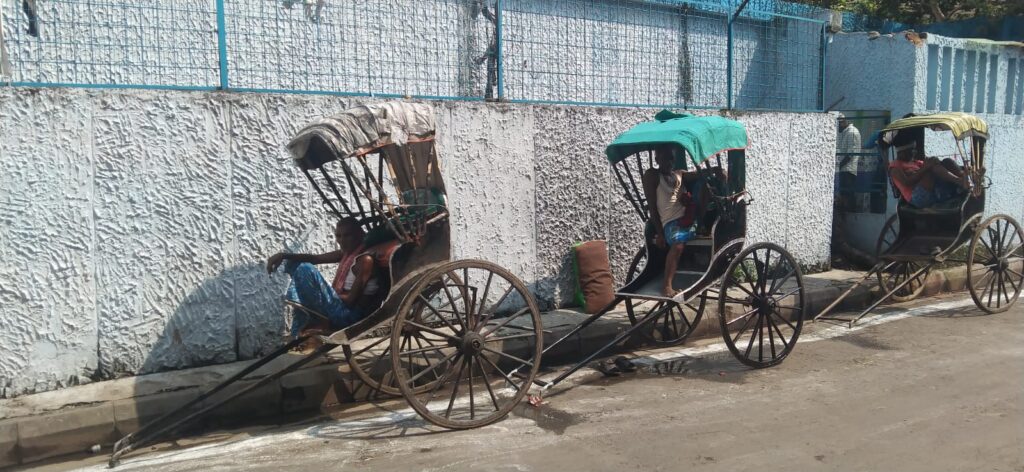The Japanese word “Jin-riki-sha” is the source of the English word “rickshaw” (jin meaning human, riki meaning power, and sha meaning vehicle; which translates to human-powered vehicle). Invented in Japan in 1869, the hand-pulled rickshaw was first made available in China in 1874. The rickshaw had the important advantage of being driven by a single person, in contrast to earlier modes of transportation like the kago, sedan chairs, etc. which required two persons to carry. In the ensuing decades, hand-pulled rickshaws experienced a boom in Japan, China, Singapore, India, Indonesia, and Malaysia. They gave millions of disadvantaged working-class families living in cities access to affordable transportation options and jobs.
The use of one human to pull another human contributed to reinforce the master-slave power structure when the British were the predominant colonial power in Asia. After World War II, colonialism in Asia began to weaken, and hand-pulled rickshaws started to disappear from use in former British territories. Strangely, rickshaws’ legacy persisted in Calcutta long after the British Empire had collapsed (1947) and the communist government of China had outlawed their use (1949). The resilient hand-pulled rickshaw not only survived in Calcutta, but it also rose to fame as a symbol of the city.
Due to the presence of this colonial artefact, Kolkata has received a lot of criticism. The Calcutta Hackney-Carriage (Amendment) Bill, passed by the state legislature in 2006, was an attempt to permanently outlaw these rickshaws, but it was never put into effect. After the change of government in 2011, pledges to replace the authorised hand-pulled rickshaws with electric or cycle rickshaws were made, but nothing has happened. If these rickshaws to be permanently removed from the streets, a viable solution must be developed to guarantee adequate rehabilitation for all those involved in the enterprise, both directly and indirectly.
Hence the rickshaw are one of the legacy of kolkata. I ask Rajendra Paswan in the early hours of the morning in Kolkata, the capital of the Indian state of West Bengal. He was putting dozens of large jute bags, which he claimed were products that needed to be dispersed across the city, on the carriage of his black and red rickshaw with the assistance of two other men.
For Rajendra, it was just the beginning of a long day of work. Fleets of hand-pulled rickshaws still cruise the streets in Kolkata, one of the last remaining cities in both India and the entire world.
They are driven by guys known as rickshaw wallahs. (The term “wallah” refers to a person who transports or obtains something.) Some people pull their rickshaws over 10 miles every day while pulling several hundred pounds, which is the weight of the rickshaw plus a few passengers. Their daily pay is typically only a few dollars.
Rickshaw drivers are not paid to transport tourists. Those passing through the city’s congested side streets or shoppers heading to and from markets make up the majority of their clientele. Children who are picked up from home and dropped off at school each day are frequently a reliable source of income. A rickshaw will suffice if someone is ill at night just as well as an ambulance.
Additionally, during the monsoon season, which typically lasts from May to September, rickshaws can be used to access locations that are inaccessible to motorised vehicles by being dragged through waist-deep water.
Over time, human rights organisations and government agencies have worked to limit the usage of hand-pulled rickshaws, which some people view as a demeaning remnant of colonial times. Although they made a commitment that the government would provide training for other livelihoods, local officials officially outlawed the cars in 2006 and stopped issuing or renewing licences.
However, for the hundreds, if not thousands, of pullers who are still working, rickshaws are frequently their only steady source of income (some estimates place the number of remaining rickshaw wallahs at between 500 and 5,000.

People like Rajendra who is pulling the rickshaw for last 40 years and running his life. It’s been a great honour and continue with his legacy of running a Rickshaw.
In the next years, tourists will be able to view reproductions of Kolkata’s hand-pulled rickshaws among the collections of museums both domestically and overseas.
As the Government of West Bengal develops a rehabilitation plan for 6,000 rickshaw pullers, hand-pulled rickshaws will soon be replaced by battery-operated modern vehicles from the streets of Kolkata. Activists and social critics have been calling for the ban of these rickshaws.
The hand-pulled rickshaw is a British legacy that may be found in Kolkata’s colonial treasure along with tea, trams, cricket, and Gothic architecture. In contrast to the city’s contemporary infrastructure, which includes skyscrapers and flyovers, Kolkata is known for its light, wooden rickshaws that are pulled by men with slender, strong bodies who are draped in lungis from the waist to the knee joint. The hand-pulled rickshaws that Kolkata’s streets will miss and bid farewell to in the coming days are discussed by Indian Eagle.
This type of rickshaw was developed in Japan in the 1870s and was influenced by that country. Prior to its arrival, the city’s highborn and aristocratic aristocracy, including zamindars and landlords, used to saunter in ornate palanquins to display their elite socioeconomic status. Hand-pulled rickshaws eventually replaced palanquins as the bourgeois alternative. The British introduced rickshaws to Calcutta in order to assert their dominance over the underprivileged Indians and demonstrate their might. Poor Indians and Bangladeshi immigrants found solace in the rickshaw-pulling profession (during Liberation War of 1971.
Hence, when they take the passenger in Bengali they say “Dada Ektu side dabayn jabo samner dike” means give me some side I will move my Rickshaw forward.